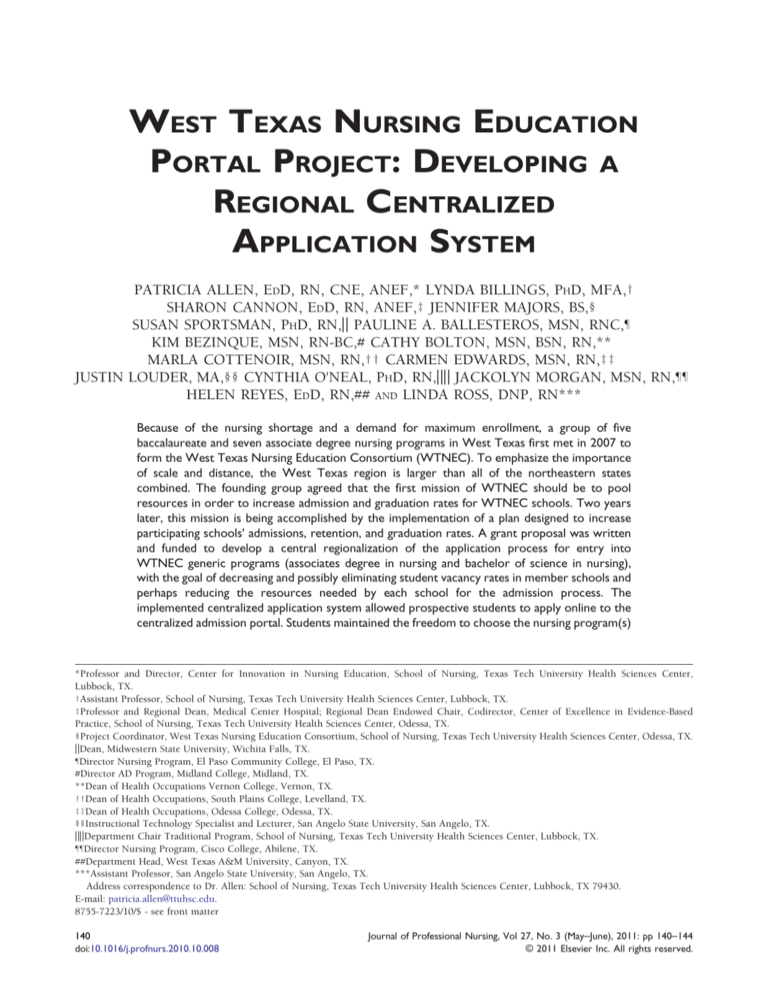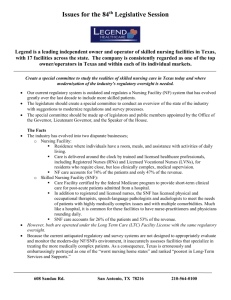
WEST TEXAS NURSING EDUCATION
PORTAL PROJECT: DEVELOPING A
REGIONAL CENTRALIZED
APPLICATION SYSTEM
PATRICIA ALLEN, EDD, RN, CNE, ANEF,* LYNDA BILLINGS, PHD, MFA,†
SHARON CANNON, EDD, RN, ANEF,‡ JENNIFER MAJORS, BS,§
SUSAN SPORTSMAN, PHD, RN,‖ PAULINE A. BALLESTEROS, MSN, RNC,¶
KIM BEZINQUE, MSN, RN-BC,# CATHY BOLTON, MSN, BSN, RN,**
MARLA COTTENOIR, MSN, RN,†† CARMEN EDWARDS, MSN, RN,‡‡
JUSTIN LOUDER, MA,§§ CYNTHIA O'NEAL, PHD, RN,‖‖ JACKOLYN MORGAN, MSN, RN,¶¶
HELEN REYES, EDD, RN,## AND LINDA ROSS, DNP, RN***
Because of the nursing shortage and a demand for maximum enrollment, a group of five
baccalaureate and seven associate degree nursing programs in West Texas first met in 2007 to
form the West Texas Nursing Education Consortium (WTNEC). To emphasize the importance
of scale and distance, the West Texas region is larger than all of the northeastern states
combined. The founding group agreed that the first mission of WTNEC should be to pool
resources in order to increase admission and graduation rates for WTNEC schools. Two years
later, this mission is being accomplished by the implementation of a plan designed to increase
participating schools' admissions, retention, and graduation rates. A grant proposal was written
and funded to develop a central regionalization of the application process for entry into
WTNEC generic programs (associates degree in nursing and bachelor of science in nursing),
with the goal of decreasing and possibly eliminating student vacancy rates in member schools and
perhaps reducing the resources needed by each school for the admission process. The
implemented centralized application system allowed prospective students to apply online to the
centralized admission portal. Students maintained the freedom to choose the nursing program(s)
*Professor and Director, Center for Innovation in Nursing Education, School of Nursing, Texas Tech University Health Sciences Center,
Lubbock, TX.
†Assistant Professor, School of Nursing, Texas Tech University Health Sciences Center, Lubbock, TX.
‡Professor and Regional Dean, Medical Center Hospital; Regional Dean Endowed Chair, Codirector, Center of Excellence in Evidence-Based
Practice, School of Nursing, Texas Tech University Health Sciences Center, Odessa, TX.
§Project Coordinator, West Texas Nursing Education Consortium, School of Nursing, Texas Tech University Health Sciences Center, Odessa, TX.
‖Dean, Midwestern State University, Wichita Falls, TX.
¶Director Nursing Program, El Paso Community College, El Paso, TX.
#Director AD Program, Midland College, Midland, TX.
**Dean of Health Occupations Vernon College, Vernon, TX.
††Dean of Health Occupations, South Plains College, Levelland, TX.
‡‡Dean of Health Occupations, Odessa College, Odessa, TX.
§§Instructional Technology Specialist and Lecturer, San Angelo State University, San Angelo, TX.
‖‖Department Chair Traditional Program, School of Nursing, Texas Tech University Health Sciences Center, Lubbock, TX.
¶¶Director Nursing Program, Cisco College, Abilene, TX.
##Department Head, West Texas A&M University, Canyon, TX.
***Assistant Professor, San Angelo State University, San Angelo, TX.
Address correspondence to Dr. Allen: School of Nursing, Texas Tech University Health Sciences Center, Lubbock, TX 79430.
E-mail: patricia.allen@ttuhsc.edu.
8755-7223/10/$ - see front matter
140
doi:10.1016/j.profnurs.2010.10.008
Journal of Professional Nursing, Vol 27, No. 3 (May–June), 2011: pp 140–144
© 2011 Elsevier Inc. All rights reserved.
WEST TEXAS NURSING EDUCATION PORTAL PROJECT
141
they wanted to attend, but they were also made aware of possible openings in other
participating schools. The admission portal also saved potential students time and money by
submitting one centralized application, resulting in consolidation of the nursing school
application process. Eleven of the 12 consortium schools participated in the centralized
application system. (Index words: Application; Centralized Application System; Consortium;
CAS) J Prof Nurs 27:140–144, 2011. © 2011 Elsevier Inc. All rights reserved.
D
RIVEN BY THE pressing issues of the nursing
shortage in the region, faculty and administrative
representatives from schools of nursing in West Texas
came together in 2007 to form the West Texas Nursing
Education Consortium (WTNEC). The first meeting
was exploratory, which included brainstorming about
universal nursing education problems such as admission, progression, and retention as well as strategies to
address these problems. The group explored ways a
multilevel nursing educational consortium could play a
unique role in developing grant-funded projects to
benefit all consortium members.
The WTNEC is composed of five baccalaureate and
seven associate degree programs in the West Texas
region. This region encompasses an area the size of all of
the northeastern states combined. The founding group
agreed the mission of WTNEC should be to pool
resources in order to increase admission and graduation
rates for WTNEC schools. Two years later, this mission
was accomplished by the implementation of a plan that
has increased participating schools' admissions, retention, and graduation rates.
One point noted at the first meeting of the consortium
was even with a severe nursing shortage, some of the
schools, for a variety of reasons, would begin the
academic year with admission slots available. On the
other hand, some schools would turn students away each
application cycle. There was no practical way to inform
students who were not accepted by their chosen school,
even though they met the general criteria for admission or
if there might be space available in another school in the
same region of Texas. The innovative solution discussed
was to regionalize the application process. This would
allow the communication necessary among schools and
prospective students to fill every available student slot in
the consortium. This would also decrease the duplication
of application activities by each individual school. As a
result, the first step in completing the mission of the
WTNEC was to increase admissions to consortium
schools by establishing a centralized application system
(CAS). Eleven of the 12 consortium schools agreed to
participate, with one withdrawing from the project due to
a commitment to another college grant, which the school
officials thought was in conflict with the activities of the
CAS. This service had not been provided to nursing
schools in Texas. A centralized application service is used
by physician assistants programs in Texas (Central
Application Service for Physician Assistants, 2010) and
by medical schools in Texas (Texas Medical and Dental
Schools Application Service, 2009).
Developing a CAS
The lead for project development was assumed by
Texas Tech University Health Sciences Center, and the
project was funded through a grant provided by the
Texas Higher Education Coordinating Board. The grant
proposed regionalization of the application process for
entry into WTNEC generic programs (associate degree
in nursing and bachelor of science in nursing), with
the goals of decreasing, and possibly eliminating,
student vacancy rates in member schools and perhaps
reducing the resources needed by each school for the
admission process. The proposed CAS would allow
prospective students to apply online to the centralized
admission portal. Students would maintain the freedom to choose the nursing program(s) they wanted to
attend, but they would also be made aware of possible
openings in other participating schools. The proposed
admission portal would also save potential students'
time and money by the development of a centralized
application to consolidate the process of applying to
more than one nursing program. One application
would suffice for all nursing programs in the
consortium. The student simply checks a dropdown
box to have the application reviewed by more than
one school.
After the funding was secured, all schools' administrative parameters were gathered and sent to a selected
vendor for inclusion into the portal. Each school required
unique tailoring of their application for inclusion in the
CAS. Outliers were weighed and discussed. The private
vendor selected for development of the CAS met with
project leaders to build a system that meets the
application parameters needed by all schools.
Centralized application systems should not be confused
with the individual school's admission process. Each
school's admissions process remained intact. The CAS
simply pulled together the application steps for all consortium schools into one portal for ease of student access for
applying to one or more consortium schools. Admission
decisions remained with each school of nursing.
Benefits of the CAS
The CAS provided a “one-stop shopping approach” to
applications for WTNEC schools and provided a database
to member schools for the following functions:
(a) record and project applicant numbers;
(b) pool demographic data of applicants applying to
WTNEC programs;
142
ALLEN ET AL
(c) track applicants for program placement and alert
applicants not admitted to their school of choice
of other school admission openings in the region.
The CAS was launched in January 2009. A userfriendly Web application facilitates the process by
allowing applicant's to
(a) complete the application in multiple visits;
(b) pay in real time (credit cards and debit cards were
accepted on a secured site; therefore, there was no
need to mail a payment later);
(c) receive tips and help through application data
validation by the CAS online support staff and the
CAS computer system;
(d) provide real-time online application status
updates at the designated schools/programs
through the applicant portal;
(e) allow dynamic interaction with the applicants
for every step of the process by the CAS online
support staff.
Applicants accessed only one portal to research and
compare the different programs in a systematic and
comprehensive way. If the applicant had any questions,
CAS support staff were available online with a click of the
mouse to chat with applicants. Additionally, the CAS
support staff processed their application to multiple
schools. The CAS was able to streamline student efforts
needed to send credentialed documents to multiple
schools simultaneously. An important additional feature
of the CAS allowed member schools to obtain statistics on
student duplicates in the application pool of WTNEC
programs. This was an important feature for regional
workforce development planning.
Participating schools of nursing have found several
benefits to using the CAS. The ease of selection of schools
when filling out the application coupled by the small
incremental fee for selecting an additional school enticed
the applicants to add additional schools to their
selections. This feature increased their chances of being
accepted to one of the 11 schools in the WTNEC CAS
project. Schools also benefited from the increase in the
number of applicants selecting their schools, and
ultimately, this increase in the applicant pool may
provide each school with a diverse and more competent
pool of applicants. The CAS streamlined the admissions
process and reduced administrative cost for schools. For
example, hours previously spent by the admissions
department answering application questions were now
answered through CAS support. Each school received
standardized applicant information facilitating application reviews by each school of nursing. Ultimately, this
reduced the manpower needed for compiling application
documents for each school. Information received by the
school was checked for authenticity through checks on
letters of recommendation and stringent quality control
measures by the selected vendor. Transcripts were
meticulously verified by the vendor to reflect accurate
grade point averages (GPAs). Each school posted their
applicant's status on the secure admission portal. At
one school, this reduced support staff time needed to
do clerical tasks of notifying students and allowed
support staff to redirect their efforts to marketing
and recruitment.
At the end of each cycle, each school obtained some
very important data. Each school in the WTNEC had
(a) an accurate number of applicants applying, (b) the
number of designations by each applicant, and (c)
matriculation data at each school and the demographic
profile of the cohort admitted (ethnicity, demographic,
geographic, and economic). This comprehensive data
served as a valuable tool to assist in applying for grants
and support lobbying efforts for state and federal
grant programs.
Additionally, the CAS assisted the schools in developing workforce projections, future trends, and recruitment
strategies based on an accurate set of data. The school
played the central role for managing career development
and minority recruitment and now had the ability to
assess and compare statistical data on applicants with
other health professions. The portal provided a platform
facilitating information exchange on individual applicants. This project has provided many benefits to all
parties, positioned the WTNEC to attract applicants,
provided a broad service to all participating schools, and
delivered key applicant data to school advisors.
Lessons Learned
The WTNEC may have been too ambitious in the choice
of a problem to address for this grant cycle. Although the
nursing shortage in Texas calls for immediate action
(Team Texas, 2008), the timeline for the creation,
implementation, and evaluation of the CAS by 11 schools
was very short. The grant cycle was 19 months. This
project required finding a vendor, developing contractual
agreements, developing the system tailored to the needs
of all consortium schools, launching the CAS at varying
times of the year based on each school's application/
admissions cycle, and evaluating the use of the CAS from
the perspective of consortium members (including
registrars and key faculty), applicants, and vendor.
Therefore, only one admitting cycle was evaluated (Fall
2009). Although the raw data generated through this
cycle was very telling, there are no comparison data at
this time. Keeping in mind this is a pilot project, the
content on the application was not able to complete
multiple iterations.
With the short timeline noted, enhancements were
deemed necessary by the WTNEC for the next admitting
cycle (Spring 2009). After the first round of admissions,
WTNEC schools were able to weigh each question on the
application and make decisions on the questions to keep
in the application yielding valuable information and
questions needing to be modified to yield more quality
data from the application process.
During the first round of project implementation,
students were required to submit additional documents
in several places if they were applying to more than one
WEST TEXAS NURSING EDUCATION PORTAL PROJECT
school. This activity was time-consuming but was easily
streamlined, as suggested by the vendor. The participating schools agreed upon a shortened application with
fewer questions. The WTNEC also recommended schools
entering this group project should agree on needed/
required documents beyond the application document.
Examples of the additional documents were letters of
recommendation, transcripts, and required immunization verification. All students applying through the portal
should submit the same documents and required
immunizations. As previously stated, the CAS was an
application site, not an admissions site. Each school
participating in the CAS must understand their college/
universities retain the decision-making role in the
admission process. The current admission process at
each school, whether done by student services or by a
nursing faculty committee, remained the same. Each
institution was still able to make all admitting decisions
independently of the portal. The portal was for the
application process only.
Another lesson learned involved each school's current
admission system. Each admission system, regardless of
the enrollment management system used by a college or
university, should be investigated to ensure seamless
integration and ease of movement of application data to
the home school from the vendor CAS system.
Prominent display of the link to the portal application
on each institution's homepage was very important for
students to have easy access to the application. Additionally, prominent display of contact information and a
link allowing each school to look at applicants and
rapidly send an electronic message thanking the applicant for applying to the school has also been suggested. In
this acknowledgement, an e-mail from the school could
note any missing prerequisite course information and
offer the student assistance, for example, “I don't see that
you have XXX. Is there any help we can offer?”
Grade point average calculations must be considered
when a CAS system is being developed. GPA calculations
will vary depending on what courses the schools request
in science and nonscience GPA determinations. Individual college's or university's grade replacement policies
will impact GPA calculations. Each school's process
needs to be investigated to yield a GPA calculation that
each school can effectively use in the verification process
for admission.
An import script was required to upload the electronic
file generated by the CAS system into the school's
existing student information systems. An import script
allows your school to import your database schema from
an existing database. College/universities with few
applications to their program would not necessarily
benefit from having an import script written after
weighing the cost of writing the script versus utilizing
existing staff to manually enter in the needed data into
the student information system. For those schools
receiving hundreds or thousands of applications, an
import script is worth the cost. The CAS vendor
provided each school's technical staff with a detailed
143
data dictionary that outlines every field, its name,
description, length, and position in the file. The data
dictionary served as a comprehensive map of the
downloadable file. Each school should inquire internally
to ascertain if in-house technical support can write the
import script before looking for a third party to do the
work for developing this import script.
Outcomes
The WTNEC met the goal of developing a CAS for
regionalizing the application process for consortium
nursing programs. The WTNEC developed, piloted, and
launched the CAS on January 15, 2009. All nursing
applicant spaces were filled in WTNEC programs for Fall
2009 semesters. As of July 2009, there were 23 out-ofstate applicants and 842 in-state applications to the
schools involved in the use of the CAS.
As noted in the introduction, duplicate applicants in
Texas were an interest of the consortium. Data were
available to determine the number of duplicate applications in West Texas by July 2009. Only 215 applicants
had applied to more than one school through the CAS.
This number reveals 24% of the applicants using the CAS
were duplicate applications. While it may be that
students who applied to the portal also applied to Texas
schools in other regions (or schools in other states), it has
been interesting to note the number of duplications of
applications. If this trend is confirmed across the state, it
may impact workforce development policy. Currently,
Texas estimates that more than 12,000 qualified applicants were turned away from nursing schools in Texas in
2008 (Texas Center for Nursing Workforce Studies,
2008). Many educators in Texas believe this number may
be an overestimate, as there has not been a mechanism for
determining duplicate applications across all schools of
nursing in Texas. If the current data hold true on the
second round of the CAS pilot project for 2010, then only
20% of the number of applicants will be duplicates.
Extrapolating this percentage to the reported number of
state applicants turned away would possibly mean only
9,600 of the 12,000 reported applicants were turned away
in Texas.
Additionally, as a consortium, enrollment numbers are
up for WTNEC schools of nursing. However, presenting
enrollment-increase data as an outcome of this project
may be misleading. Texas as a state has been incentivizing
schools of nursing to grow enrollments over the past 2
years in all 94 schools of nursing. This timeline for
growth of nursing schools has coincided with the
implementation of the CAS project; therefore, drawing
any conclusions on the effect of the CAS on enrollments
in WTNEC schools would not be sound. Nevertheless,
enrollment of nursing students is at an all-time high in all
regions in Texas.
Conclusion
Eleven schools came together and formed a consortium to
address one aspect of the pressing issue and mandate to
increase enrollments and graduation rates in nursing
144
schools in Texas. The CAS was the first step in addressing
the issue of increasing enrollments. The CAS process
allowed the student to “one-stop shop” for West Texas
schools of nursing. Additionally, the CAS allowed schools to
gather admission data about qualified applicants and assess
“the true number” of duplicate applicants in this region.
Although a short project timeline has been noted, the
schools met multiple times to complete the project. The
groundwork for a productive partnership for West Texas
is now in place. The product envisioned in the grant is in
place. The foundation for a lasting partnership in nursing
education in the West Texas region has been established.
This project has given the schools in the consortium a
foundation for sharing, communicating, and exploring
solutions to expanding enrollments as well as increasing
graduate rates in West Texas. These are important tasks
for the WTNEC in order to meet the need for nurses in
ALLEN ET AL
the future in this region. To learn more about the West
Texas Portal project, visit the following websites: https://
portal.wtnec.org/ and http://nursing.ttuhsc.edu/wtnepp/.
References
Central Application Service for Physician Assistants (CAPSA).
(2010). Retrieved on March 30, 2010, from https://portal.
caspaonline.org/.
Team Texas. (2008). Texas nursing: Our future depends on
it. A strategic plan for the state of Texas to meet nursing
workforce needs of 2013.
Texas Center for Nursing Workforce Studies. (2008). 2008
Update on student admission, enrollment and graduation trends
in professional nursing programs. Retrieved on March 17, 2010,
http://www.dshs.state.tx.us/chs/cnws/2008_EnrlGrad.pdf.
Texas Medical and Dental Schools Application Service
(TMDSAS). (2009). Retrieved on March 29, 2010, from http://
www.utsystem.edu/tmdsas/.







